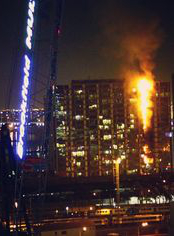Expert pushes hard line on cladding
 An industry insider says Australia needs full-scale testing of all cladding materials for fire safety.
An industry insider says Australia needs full-scale testing of all cladding materials for fire safety.
Kingspan Insulated Panels building technology director Mark Harris has given an address in Melbourne in which he called for a tough new testing regime.
He wants large fire sources to be applied to significant areas of cladding material used in high-rise construction across Australia.
Many forms of cladding including aluminium composite panels contain combustible materials like polyethylene. However, there is often confusion about compliance for façade systems, which means that some buildings have been clad with materials outside the requirements of the Building Code of Australia.
Mr Harris said the US, the UK and the UAE all have very tight regulations for façade cladding materials, featuring large-scale testing to make sure the materials perform well and do not ignite in large scale situations.
He said cladding should be inspected after it is installed too, so that the presence of combustible cladding in buildings is recorded.
The issue of combustible cladding was thrust dramatically into the Australian spotlight in 2014 after a fire on the eighth floor of the Lacrosse building at Melbourne’s Docklands.
The blaze shot up the side of the building, igniting up to the 21st floor in just minutes, and subsequent investigations by the Metropolitan Fire Brigade found combustible cladding on the façade to be a key factor.
This led to an investigation of the city’s 170 major apartment towers by the Victorian Building Authority, which found that over 50 per cent contained cladding that was non-compliant with BCA standards.
The Lacrosse building and one other – Harvest Apartments in Clarendon Street, South Melbourne – required immediate action.
The National Construction Code does currently require cladding materials to be tested, but the acceptability of the materials has been determined by small-scale reaction to fire tests with fairly small fire sources and sample sizes.
While this might filter out some of the worst performers, Kingspan technical director Dr Mark Tatem says large-scale testing is need for a proper indication of how cladding would behave in a real fire scenario.
Standards Australia and the Australian Building Codes Board have produced new standards based on large scale fire testing, but Harris said they must go further.
“What they need to do is make this testing mandatory so that every new building which is clad with these materials has to go through a mandatory fire test on a large scale so you can make sure that those materials are not going to cause a fire hazard to the occupants of the building,” he told reporters.







 Print
Print